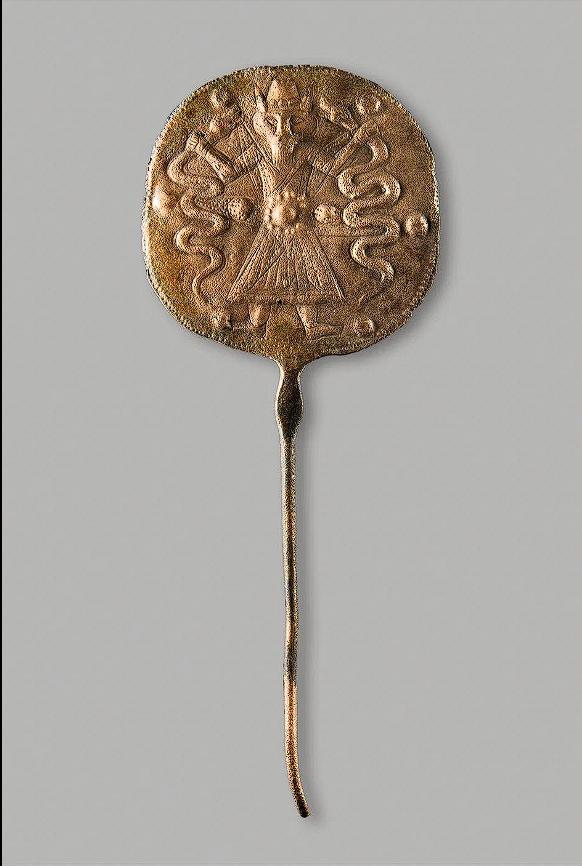Deep within the archaeological treasures of Luristan, western Iran, lie artifacts that transcend mere decoration. Long bronze hairpins, adorned with intricately designed disks, offer a window into the ancient world’s complex mythology and social structures. These artifacts, more than just hair accessories, reveal a culture deeply rooted in symbolism and the enduring struggle between order and chaos. Join us as we explore the captivating stories hidden within these ancient relics.

The Artistry and Function of Luristan Bronze Hairpins
- Beyond Decoration: Symbolism in Daily Life:
- These bronze hairpins, featuring large, disk-shaped tops, were likely used to secure elaborate hairstyles, particularly among the nobility. Their presence signifies the importance of personal adornment and social status in ancient Luristan.
- The possibility that these hairpins were used by both men and women opens a fascinating discussion about gender roles and fashion in this ancient society.
- The varied decorations on the disks, ranging from geometric patterns to representational imagery, underscore the artistic sophistication of the Luristan culture.
- Intricate Designs: A Window into Ancient Beliefs:
- The intricate decorations on the hairpin disks, including figures grappling with serpents, provide valuable insights into the mythological beliefs of the time. The imagery evokes comparisons to heroic figures, suggesting a culture that valued strength and control.
- The “Master of Animals” motif, a recurring theme in ancient art, appears on these hairpins. This motif, depicting a human figure flanked by subdued beasts, symbolizes the control of chaos and the triumph of order.
- Tracing the origins of this motif to Mesopotamian art, including 5th-millennium BCE stamp seals from Tappeh Giyan, highlights the interconnectedness of ancient cultures in the region.
- Cultural Connections: Elamite Influence and Beyond:
- The presence of similar motifs on chlorite vessels from southeastern Iran during the 3rd millennium BCE reflects the vast reach of Elamite influence. This connection highlights the cultural exchange between distant regions and the spread of artistic ideas.
- The Elamite civilization, with its capitals at Susa and Anshan, played a crucial role in connecting diverse cultures, influencing artistic expressions across a wide geographical area.
- These hairpins serve as tangible evidence of the cultural exchange that happened in the ancient near east.
Myth and Power: The Symbolic Significance of the Hairpins
- Mythological Monsters: Tiamat’s Legacy:
- In Mesopotamian mythology, serpentine monsters were believed to be the venomous offspring of Tiamat, the chaotic force associated with the underworld and death. This connection underscores the ancient fear of chaos and the importance of its control.
- The myth of Marduk vanquishing Tiamat’s demonic commanders highlights the role of deities in maintaining cosmic order. This narrative reflects the ancient belief in the power of benevolent deities to protect against evil.
- The Myth of Etana further emphasizes the duty of rulers to keep these chaotic forces in check, reflecting the importance of maintaining stability in ancient societies.
- Apotropaic Function: Warding Off Evil:
- Given the turbulent historical context of the 1st millennium BCE, with the decline of the Elamite civilization and the rise of powerful empires like the Neo-Assyrian, these artistic representations likely served an apotropaic function.
- The hairpins, with their powerful imagery, may have been used to invoke the protection of kingly deities such as Marduk and Inshushinak, the tutelary god of Susa.
- This apotropaic function highlights the ancient belief in the power of art to ward off evil and bring good fortune.
- Enduring Beliefs: Order Versus Chaos:
- The symbolism embedded in these bronze hairpins reflects the enduring belief in divine guardianship and the necessity of subduing chaos, a concept that persisted throughout the ancient Near East.
- These artifacts serve as a reminder of the ancient struggle between order and chaos, a theme that resonates across cultures and time periods.
- By understanding the symbolism of these hairpins, we gain a deeper appreciation for the complex worldview of ancient societies.
The Legacy of Luristan: Ancient Stories in Bronze
- Archaeological Treasures: Unveiling Ancient Lives:
- The bronze hairpins unearthed from Luristan are more than just artifacts; they are windows into the lives and beliefs of an ancient civilization.
- These objects allow us to connect with the people who lived thousands of years ago, providing insights into their daily lives, artistic expressions, and spiritual beliefs.
- Cultural Heritage: Preserving the Past:
- Preserving these artifacts is crucial for understanding our shared human history. They serve as tangible links to the past, reminding us of the rich tapestry of ancient cultures.
- By studying these objects, we can learn valuable lessons about the ingenuity, creativity, and resilience of ancient societies.
- Inspiration for Today: Ancient Wisdom:
- The themes explored in the art of Luristan, such as the struggle between order and chaos, continue to resonate today. These ancient stories offer timeless insights into the human condition.
- By appreciating the wisdom of the past, we can gain a deeper understanding of ourselves and our place in the world.
These Luristan bronze hairpins, with their intricate designs and powerful symbolism, offer a captivating glimpse into the ancient world. They serve as a testament to the enduring power of art and mythology to shape human understanding and belief.

CÁC TIN KHÁC
Mary Walton: The Forgotten Inventor Who Helped Clean Up America’s Cities
Tomb of Queen Nefertari in the Valley of the Queens, Egypt
Discover the Hypostyle Hall of the Temple of Hathor at Dendera
Venus de Losange: Unveiling the Mystery of a 20,000-Year-Old Paleolithic Icon